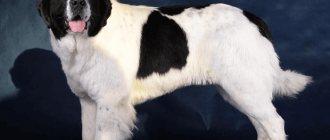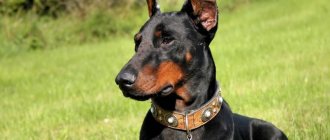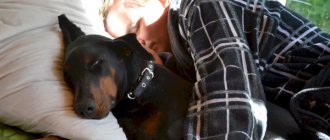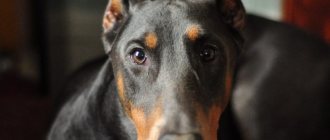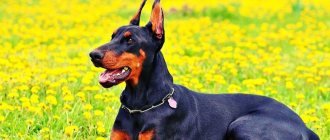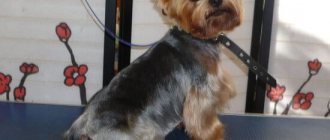Appearance and characteristics of the breed
Representatives of the breed look like proud Akhal-Teke horses. Some lovers compare Dobermans to graceful deer, the animals are so graceful.
According to FCI standard No. 143, a typical representative of the breed looks like this:
- The physique is strong and muscular.
- Elegant body lines.
- Proud and slender posture.
Such a dog was considered anatomically normal. Today the breed standard has changed somewhat. Light and lean brothers are gradually being replaced by dogs that are more reminiscent of Molossians. The difference in appearance is especially noticeable in docked and undocked animals.
As for the characteristics of Dobermans, perhaps they are one of the most owner-oriented dogs. The pet will look into the eyes and ask without words: are we going to play? What should I do for us to play?
With the right motivation, representatives of the breed work simply brilliantly: on the drive, with sparkling eyes and smiles from ear to ear.
History of the origin of the breed
In 19th-century Germany, there lived a tax collector and part-time policeman named Karl Friedrich Louis Dobermann. Due to his activities, the man needed a brave, angry dog who could protect him in case of danger. Local dogs were completely unsuitable for the assigned role, but Dobermann bought the most vicious and powerful ones from the knackers, trying to breed a new breed.
It is known that the ancestors of Dobermans were “butcher dogs” or Rottweilers. According to one version, Rottweilers and German pinschers themselves took part in the development of the new breed. Another version says: Dobermans appeared thanks to Great Danes, “butcher’s dogs,” Beaucerons and other breeds. Allegedly, stud books were not kept in those years, so the history of the origin of Dobermans is shrouded in mystery.
The first exhibition in which the new breed participated took place in 1897, and a couple of years later the first Breed Lovers Club was created.
The first Dobermans appeared in the Russian Empire in 1902. The then professional dog handler V.I. became an active promoter of the breed. Lebedev. The man had connections with those close to the royal court, which contributed to the rapid spread of Dobermans in the search and guard branches of the police service.
In 1972, DOSAAF classified Dobermans as decorative breeds. True, already in the summer of 1973 the breed was again “returned” to the ranks of service workers.
Doberman colors
Although only two colors are indicated in the description of the breed, walking around the city you can see a variety of colors, we found the most common ones on the Internet.
white Doberman or albino Doberman
black doberman
brown or chocolate Doberman
red doberman
blue doberman
Related article:
Dangerous dog breeds - lists of the TOP 10 breeds abroad and in Russia . Perhaps you like a certain breed and want that particular dog, but is it on the list of dangerous dog breeds? You can find out about this by reading a separate article, where a list of aggressive and angry dogs is published.
Types of Dobermans
- european doberman
- American Doberman
- sometimes the Russian Doberman is also distinguished
Similar breeds:
- german pinscher
- miniature pinscher or mini doberman
Left: American Doberman, Right: European Doberman
Apart from slight differences in appearance, American and European Dobermans also have slightly different personalities/temperaments.
American Dobermans are very affectionate, tend to jump on their owners, and have a goofy behavior reminiscent of Golden Retrievers.
European Dobermans love all family members, but for this reason they are more wary. Sometimes their excessive care causes a number of problems. These dogs are more energetic and always give their best. Larger version of the Border Collie. This is a plus for a working dog, but a minus for an apartment companion dog.
German Pinscher. Sometimes called the German Doberman. Considered the progenitor of the Doberman Pinscher. In appearance they are closer to the American one, but the coloring is close to the European one. The German relative is medium in size, ideal for apartment living.
The Miniature Pinscher or Mini Doberman is absolutely identical to its counterparts, and the main difference is only the size.
The so-called Russian Dobermans are similar in every way to their German relatives, since it was from there that they were brought to us in Russia.
Breed standard RKF and FCI
Breed standard No. 143 dated February 14, 1994 states:
- BASIC PROPORTIONS: The Doberman's format is almost square, especially in males. The length of the body (from the sternum to the ischial tuberosity) should not exceed the height at the withers by more than 5% in males and by more than 10% in females.
- HEAD: When viewed from above, the head resembles a blunt wedge. The transition from forehead to muzzle is pronounced.
- EARS: Vertical, set high, docked in accordance with the length of the head. Uncropped ears should be of medium size, with the front edges lying close to the cheekbones.
- EYES: Medium size, oval, dark in color. In brown dogs, a lighter shade is allowed.
- MUZZLE: Should be in correct relationship with the cranial part of the head, strongly developed, the opening of the mouth should be deep, reaching the molars. The muzzle should be of sufficient width in the area of the upper and lower incisors.
- NOSE: Wide, with round nostrils. Black dogs have black, brown dogs have brown.
- JAWS AND TEETH: Jaws wide and strong, scissor bite. The dog must have 42 teeth, correctly set, of standard size.
- NECK: Quite long in proportion to the body and head, dry and muscular. Neck with a rising and beautifully curved line, straight and noble carriage.
- WITHERS: Should protrude in height and length (especially in males) and thus determine the direction of the back line ascending from the croup.
- BACK: Short, strong, broad and muscular.
- LOIN: Wide and muscular. The bitch can be a little longer in the lumbar region, as she needs space for her mammary glands.
- Croup: Wide and muscular, should slope slightly from the rump to the base of the tail and therefore appear fairly rounded, being neither straight nor sloping.
- CHEST: The length and width of the chest should be in correct proportion to the length of the body, and its depth, together with the slightly sprung ribs, should be approximately half the height at the withers. The chest is quite wide with a particularly emphasized and pronounced anterior part.
- LOWLINE AND ABDOMEN: The abdominal wall is noticeably tucked from the end of the sternum to the pelvis.
- TAIL: Set high and docked short, retaining two distinct caudal vertebrae. In countries where tail docking is prohibited by law, the tail may be kept natural.
- HAIR: the hair is short, hard, thick, fits tightly and smoothly to the skin, evenly distributed over the entire surface. The presence of undercoat is not allowed.
- COLOR: Black or dark brown with rusty red, reddish red, clearly defined and clean tan markings. Tan marks are located on the muzzle in the form of spots on the cheekbones and above the upper eyelids, on the throat, on the chest in the form of two spots, on the pasterns, metatarsals and paws, on the inner surfaces of the thighs, around the anus and on the ischial tuberosities.
- HEIGHT AND WEIGHT: for males: 68 - 72 cm, for females: 63 - 68 cm, weight for males: approximately 40 - 45 kg, for females: approximately 32 - 35 kg.
Diseases and health problems
There is a bitter opinion among modern Dobermans: if a dog has lived to be 8 years old, it is considered a long-liver. And if a pet manages to reach 10 years of age, they look at it as if it were a curiosity from another planet.
The lifespan of modern Dobermans is, on average, 5-7 years. The main diseases that claim the lives of pets:
- DCM. Almost 60% of the breed is susceptible to this heart disease. We won’t go into veterinary terms, but let’s just say: there are two types of disease development. In the first case, after diagnosis, the dog spends the rest of its life on the couch, taking a certain medicine. In the second case, the animal dies instantly: during training and play, just at home. When planning to purchase a Doberman, the future owner will have to accept DCM as a given and come to terms with its possible appearance in his own pet. Otherwise, it is worth considering a different breed.
- Oncology. Almost all pedigrees of modern dogs contain either DCM or cancer. Comments are unnecessary here.
- Von Willebrand disease is a bleeding disorder characterized by sudden bleeding. The disease is hereditary.
- Wobbler's syndrome is a disease of the cervical spine. The disease can be either congenital or acquired.
- Narcolepsy is a neurological disease characterized by sudden “falling asleep.” At the time of the attack, the animal becomes numb, and there is a short-term loss of control over the limbs. Narcolepsy is a genetic disorder.
- Gastric volvulus is a disease common to most large breeds. Volvulus is believed to be a hereditary disease.
- Hip dysplasia is not as common in Doberman Pinschers.
- Tendency to allergies.
Before purchasing a puppy, it is advisable to look into Doberbaza. Here you can find information about the ancestors of the desired puppy, more or less track the diseases of the parents, grandparents, etc.
Diseases
Doberman diseases are caused by genetic defects. A healthy dog can live up to 16 years. The owner's task is to regularly take the pet to the veterinarian. The dog may be diagnosed with:
- Allergy to dust, pollen, which can even cause ulcers on the skin.
- Diseases of the cardiovascular system: tachycardia, arrhythmia, heart failure, coronary heart disease. If your dog has difficulty breathing, problems with balance, or even falls when walking, then you should show it to the veterinarian; these may be symptoms of heart disease.
- Diseases that are hereditary in nature. Among them is gastric volvulus, which is characteristic of all dogs with a wide chest. Poor nutrition can only provoke the problem. If this disease occurs, the Doberman begins to behave nervously, he experiences bloating and salivation, vomiting, and pain in the abdominal area.
- Narcolepsy, which is accompanied by sleep disturbances and a decrease in muscle tone after active walks or outdoor games.
Character and habits
It is impossible to paint Dobermans with one brush, because there are as many characters as there are dogs.
Let us highlight the main features characteristic of the breed:
- people-oriented;
- curiosity;
- ease of climbing;
- excellent learning ability;
- cunning;
- mobility.
This dog, with the right approach to training, can become an excellent companion. Due to its high focus on the owner, if the owner is focused on the dog, the tandem can work wonders.
Pros and cons of the Doberman
Pros:
- Friendliness and peacefulness are the most striking character traits of this breed;
- Doberman and children - dogs truly love to play with kids and show great affection for them;
- Poise, intelligence and strength;
- Excellent trainability;
- External attractiveness of the dog.
Minuses:
- Aggressive in defending territory – Dobermans tend to defend their family and their territory. It will never attack unless its owners are, in the animal's opinion, in danger;
- The need to demonstrate the owner’s strong character for harmony in the “dog-owner” relationship. However, this is a conditional minus, since a strong character of the owner is required for any breed;
- Pet's psyche and wayward character.
Care and maintenance
A huge request to people who want to buy a Doberman: NEVER buy this breed just because it has a good exterior. The Doberman is not a sofa cushion, not a beautiful addition to furniture. This is a very serious breed that requires endless investment of effort, time and money.
This is not to say that a healthy dog needs special care. Comprehensive vaccinations, trimming nails every 21-30 days, rinsing in the shower after walks, timely walks and quality feeding. As for the content, this issue should be approached in more detail.
At the initial stage, the puppy will need:
- two bowls (for food and water);
- quality food;
- box or cage (you can immediately take for growth, for example, a “six”);
- box for transportation in a car, if available;
- a warm suit if the pet is purchased in the cold season;
- collar and leash;
- toys (pullers, dog-likers, balls on a rope produced by Gappay).
If the owners plan to engage in training and pass the VN and IGP standards, the following will be added to the initial purchases:
- leashes for tracking and protection;
- harness for protection;
- training balls;
- parfors for behavior correction (strictly under the guidance of a professional dog handler!);
- visiting the training area at least 2 times a week;
- trips to the fields to practice the trail (from April-May to October);
- purchasing your own pads and sleeves for practicing the protective section (at the request of the owners).
It's already scary, isn't it? And most importantly, this requires time and the desire of the owner. Oh yes, the most important thing was not written: an annual heart examination is mandatory for this breed.
How do Dobermans treat strangers?
Dobermans are very wary of strangers, feeling they are a threat. She will warn a stranger with a loud bark. If he does not leave, the dog will try to reach him to bite or hit him. But he will attack only as a last resort.
Dobermans prefer quiet environments, so loud noises, screaming or crying can frighten him. They also do not like people under stress.
The protective instinct of this dog begins to work when the familiar atmosphere is disturbed by an extraneous sound or person. This quality of the Doberman makes him examine the entire territory until the irritant is found.
When this object is found, the Doberman will try to drive it away from its territory. Often begins to show aggression without first calculating his strength. Therefore, early training is mandatory for representatives of this breed.
Education and training
Doberman is a breed that must pass at least the OKD or pass the VN. Not just to pass for the sake of a diploma, but to obey the owner outside the training area. First, obedience is the key to a long and happy life. Perfect obedience and following commands without hesitation may one day save your pet.
Education begins from the moment the tiny paws cross the threshold of a new home. The owner must be consistent in his actions; physical violence against the puppy is unacceptable, but sometimes you have to restrain the pet. For example, the baby got too excited while playing and bit him painfully. In this case, the owner can exclaim the word “hurt” and immediately stop the game.
Correct behavior is rewarded with play and treats, and incorrect behavior is corrected. As for training, it is advisable to start it at the age of 2.5-3 puppy months. Up to 4-4.5 months, Dobermashkas learn about the world around them and absorb into themselves like a sponge. At this time, it is especially important to establish contact with the puppy, which is done through play, praise and encouragement.
Training should also be based on the principles of play: if you perform an action, you will receive a treat or a toy. In general, it is better to take the first steps in training on a treat; you will have time to transfer to a toy.
You just need to choose a good dog handler; it is better for beginners not to experiment with self-training. There are high chances of not seeing the inaccuracies of your actions and the unwanted behavior of the puppy. Correcting “jambs” is not the easiest task.
Feeding and diet.
Oh, feeding Dobermans is a different story. The problem is that these dogs are very allergic, and recommending anything on their menu is such a pleasure.
Choosing a diet for a specific dog can only be done by trial and error. For some, the cheapest dry food is suitable, while others can only eat holistic food. And still others eat natural food and don’t know grief. In general, everything is very individual.
Puppies up to 3 months are fed 5 times a day, from 3 to 6 months - 4 times. Starting from the age of six months, the pet can be transferred to three meals a day. And a 9-month-old Doberman is quite capable of eating twice a day.
If your dog is on a natural diet, it is advisable to exclude chicken and beef from its menu. These products are allergens and, accordingly, can provoke an allergic reaction in a Doberman.
Diet for Doberman dogs
Dobermans, like any dogs, should not be given sweet or salty foods. If you feed your dog natural food, it must be balanced.
Up to one and a half years old, you can feed your dog chicken eggs and meat, steamed vegetables, berries and fruits, and then switch to dry food. But don’t forget to give treats in the form of natural food.
Price, where and how to buy, cost of a puppy
Step-by-step instructions for those wishing to purchase a puppy:
- Actively studying information about the breed in Doberbase and social network groups. For example, here and here
- Determining the purposes for which the dog is needed, including visiting exhibitions or sports training. In the first case, it is better to choose a show-level dog; in the second, you should pay attention to litters whose mother, for example, is a show dog, and whose father actively works on the training ground and shows excellent results. It's not easy, but who said that choosing a puppy is a nonsense and quick thing?
- Choosing a trusted kennel that has proven itself among breed lovers. By the way, information about nurseries is in the indicated groups.
- Track litters in the selected nurseries or nurseries.
- Determining the litter from which you want to adopt a puppy.
- Call the breeder or owner of the bitch. Tell us about yourself, your goals for purchasing a puppy, be sure to ask about the parents, ask for a video of their work.
- Ideally, visiting the training area and watching the actual work of one of the parents.
- Choosing a dog handler. Hint: there is a Dobermann dog handler in Moscow, you just have to look for it. Call a specialist, agree on future classes.
- Visit to the breeder three weeks after the puppies are born.
- Getting to know your pet. The puppy may refuse to be a completely different baby than the one chosen from the photo. It happens that at first you liked one puppy, and when you met, your eye fell on his littermate. But this is fraught, because puppies from promising parents are usually booked in advance.
- Joyful anticipation and anxiety over the next few days.
- Hurray, finally! The puppy moved to a new home. Happy new life, dear owners!
And now about the cost. Today, the price of Doberman puppies varies between 70,000 rubles and 150,000 rubles. The cost depends on the reputation of the kennel, the titles of the parents and, for working dogs, the corresponding qualities.
How long do Doberman dogs live?
The lifespan of a Doberman is 11-13 years. To create good offspring, the breeder must exclude family ties, and also introduce the bitch to the male so that they can accept each other.
A female gives birth to 8 puppies in a litter. For the first month of life, puppies must be with their mother so that she can feed them milk. This will be the basis for good health of puppies.
Owner reviews
Dobermanns talk about their favorite pets like this:
“My favorite pie! This is my-my dog."
“If you still decide to adopt a Doberman, then, with proper training, you will get a very smart, kind dog, attached to its owner.”
“She, of course, is an infection... But she is so beloved!!!”
“Before getting a Dober, you need to weigh the pros and cons. Dobermanns probably require more time for training and attention than anyone else, but this is only due to the fact that they are very people-oriented and are ready to do anything to get attention.”
“Once you get to know this breed, you don’t need another!”

